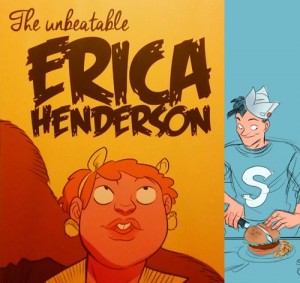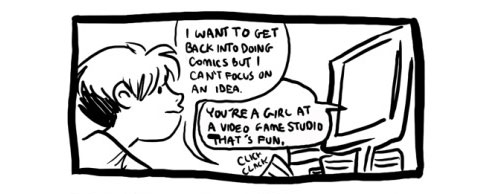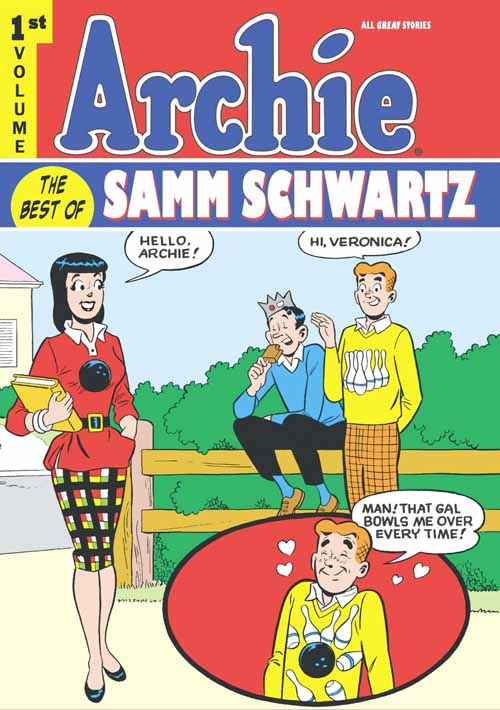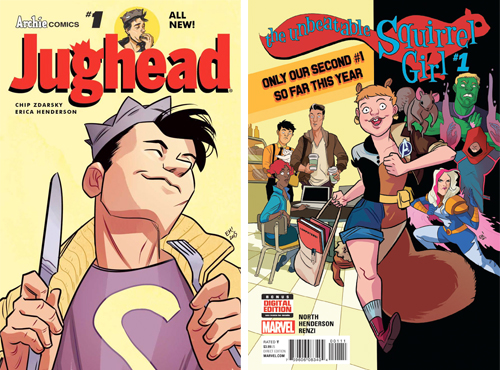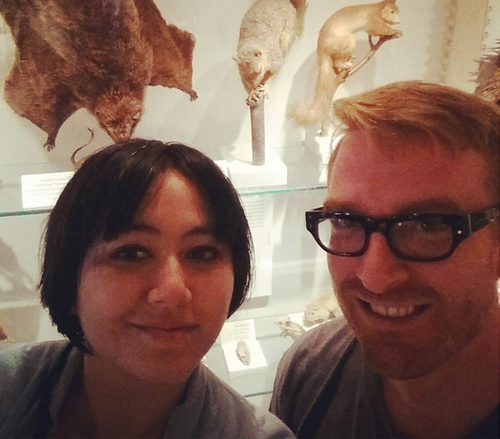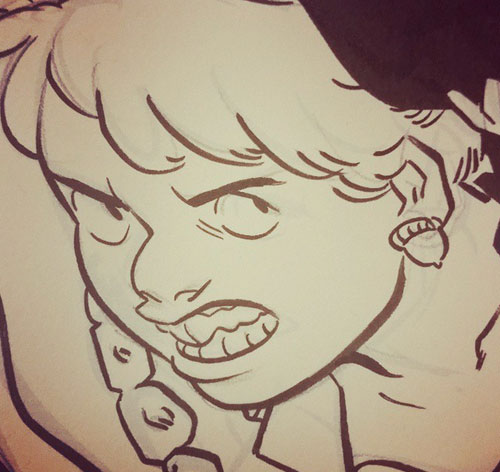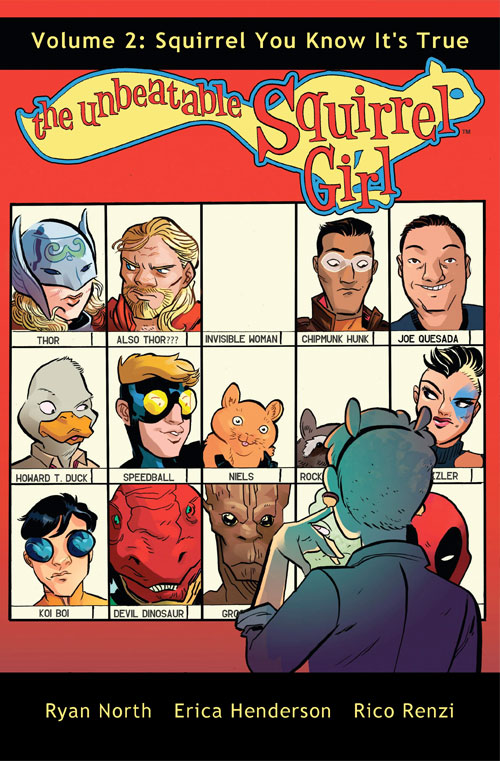An Interview with Erica Henderson by Hub Comics’ Jesse Farrell
Erica Henderson is currently series artist of Marvel Comics’ THE UNBEATABLE SQUIRREL GIRL (with writer Ryan North) and more recently was tapped by Archie Comics to relaunch JUGHEAD with writer Chip Zdarsky. Prior to that she worked in animation, as an art director in the videogame industry; drew issues of SUPER SECRET CRISIS WAR: JOHNNY BRAVO for IDW and ATOMIC ROBO PRESENTS REAL SCIENCE ADVENTURES for Red 5 Comics; successfully crowdfunded BABY’S FIRST MYTHOS, a collaboration with her father, writer CJ Henderson; co-created SUBATOMIC PARTY GIRLS with Chris Sims and Chad Bowers for Monkeybrain Comics; and for several years she drew the web comic THE GUILDED AGE.
Henderson is also a frequent visitor to Hub Comics, and a good friend. It’s been great to see the world recognize her amazing talent, humor, and her herculean work ethic. We met for lunch at Union Square’s Ebi Sushi on Tuesday, October 20th, a couple of weeks after the premiere of JUGHEAD #1, and the week before THE UNBEATABLE SQUIRREL GIRL Volume 2, #1 came out. -JF
STARTERS
We just watched the new Venture Bros. trailer for season six and that looks awesome. You worked on Venture Bros.
I did. I worked on season three.
How did that come about?
Well that was pretty easy: I saw that there was an open thing that I could interview for and I went for it. I think the funniest part was when I was talking to them; they asked if I would want to be a studio intern or a Venture Bros. intern. I was like “why would you ask that question? [Laughter] What sort of dumb question is this?” Probably whoever got there first got to be a Venture Bros., everybody else got stuck with, like, the other stuff.
Not ‘cause they were doing uncool stuff; they also did the Gotham Girls cartoon and things like that, but…
This was Titmouse [Animation Studio]?
It’s Titmouse now, at that point it was World Leaders Entertainment.
…Before that is was Noodle Soup [Productions].
Was this after you graduated [from the Rhode Island School of Design]?
No, I was an intern. It was between my junior and sophomore year. Because the next summer was when I worked on [the 2007 live-action movie] Underdog. [Laughter]
Right! What did you do on Underdog?
Um, I was a set-dressing intern.
Okay, and what did that entail?
Not as much as you would expect, because the guilds and unions are so strict that just having some kid help you hang some frames on a fake house on a soundstage was, like… really bad. I remember some of the set dressers were like “hey, you wanna come help out?” and I was like “am I allowed to do that?” They were like “Oh… I guess not. [Laughter] But there was some stuff I got to do.
Did you learn anything in particular?
I learned how strict the unions are! That was my first taste of that. And how hard it is to break into films because of them. [Laughter]
Which wasn’t the case on Venture Bros. because animation doesn’t–
Yeah, it’s different.
Yeah, animation’s much more like… “Can you do it? Okay, you’re hired.”
“All right, we’re done with this job. You’re fired.” Or not fired, it’s contract [work] and now you’re on to the next job. I knew people who were working there who were so-
I’m sorry, working at?
In animation in New York.
Yeah, okay.
Who were part of this [cycle of] work on one part of this, when you’re done when- the- season’s-over cycle. But there’s so much, that people who worked freelance didn’t have a break for three years.
Uh huh, okay.
[Food arrives]
I think it’s a difficult business, but once you’re in, you’re kinda in.
And what did they have you doing on Venture Bros.?
When I started, what I was doing a lot of was setting up the storyboards for animatics. For those of you who don’t know, it’s basically an animated storyboard that they put the sound over so you can watch the whole thing play out. And then I started prepping the backgrounds from the background artist so they could be send to Korea and painted. I would take his line drawings that he did in pencil, and then take them into Flash [animation program], and then just… I was almost flatting [a preparatory step in computer coloring] them. There was no linework in what I sent out, but I’d separate out every single little shape in Flash.
Oh, okay.
And it was a different shade of gray for each little area. And then they [the Korean animation studio] would go in and use that and the drawing to do a painting of the background. Which didn’t always work out because even with both those things, there would be times where… Denny [Finkel], who was the background guy, he would [draw] guidelines and they wouldn’t be looking at what they were doing, they’d just be going as fast as they can, ‘cause it’s a horrible industry…
[Jesse laughs]
Because they’re just interpreting the lines as best they can in Korea?
It’s not even that… I think if they had time to think about it, they would, but they’re just doing it as fast as they can, so they just drew every line. I don’t think it’s, like, a personal failing as much as they’re in this factory…
And they’re working really, really fast. Right. So you did that for a summer?
Actually, that’s where I first got to use a Cintiq [digital drawing tablet] because there was a point where all the artists were out. And just everyone was on vacation at the same time, so I got to ink some of the character designs.
Cool!
That was neat!
That’s cool. The character designs… Like the model sheets?
Model sheets. Yeah.
Wow! Do you remember which characters?
It was Dr. Quymn. Not the one in the episode that Doc [Rusty Venture] falls for, but her mother that Doc’s father falls for.
Gotcha! Cool. A part of Venture history!
FROM A TINY ACORN…
So I want to go back to the beginning, Erica. [Laughter] So you were born in New York?
Mm-hmm!
And I find this interesting: your mom is in fashion and your dad was a sci-fi writer, and I feel like both these things come into play in your work. Would you say that’s a fair assessment?
That’s true, although I feel like the fashion thing came in a lot later, I think because of my mom’s more traditional values, and me, I rejected a lot of fashion… I didn’t, like [affects disenfranchised hippie voice] I didn’t buy into it, man.
Okay, gotcha! [Laughter] Youthful rebellion!
But after a while… It was something I had to accept on my own terms before I was comfortable with it. Because before it wasn’t on my own terms and so I didn’t like it.
That makes sense, but it’s surprising to me because you’re one of the most stylish people I know.
[More food arrives]
And I feel like a lot of your dad’s taste was an early exposure to a lot of things that you like today?
Yeah, I’d say that’s true.
So you had a lot of exposure to not only sci-fi, but comics as well?
Yeah, there were a lot of comics- and books- in the house, and yeah, I was exposed to a lot of things that I think a lot of people wouldn’t have been exposed to because they were older books at that time.
You have this grounding in classic sci-fi that’s really cool. What were some of your favorite comics growing up? What were some of the most influential? I know you were an Archie fan prior to drawing Jughead.
I was an Archie fan. I think with that one, I was more influenced strictly by Dan DeCarlo. I looked at him… And Samm Schwartz more than other people because they had very distinct styles. One of the things I really liked as a kid was the little-known Young Heroes in Love [A DC Comics series published in 1997-98]. This was for me an early kind of [realization that] “oh! Superhero stories can be anything. They’re just people who do a job and they have other things going on in their lives.”
And, you know, melodramatic soap opera is basically what superhero stories already are, so it was kind of a logical next step.
I want to go back to Samm Schwartz for a second. You were the one who taught me about Samm Schwartz, who I was somewhat aware of…
It wasn’t until more recently that the [Archie] digests started crediting artists. Before they very adamantly didn’t credit artists. So it was difficult to find out who these people were, even if you could recognize them from story to story. So yeah, it’s totally understandable…
But he was kind of the distinctive Jughead artist of his era.
I only ever saw him on Jughead stories, so I don’t know if there was some sort of “I’ll only draw Jughead!” deal or what.
Dan DeClarlo drew kind of the Platonic ideal Archie in a lot of ways, like when we think of Archie-
Yeah, everyone started doing Dan DeCarlo, even though Bob Montana started it and he had a very distinct style, but once Dan DeCarlo took over, everyone started doing Decarlo.
Since there was a predominant house style, what distinguished Schwartz from DeCarlo?
There were a couple of things. One of the things I noticed first as a kid was Samm Schwartz always sort of threw in background gags that would run throughout scenes. I don’t think they were part of the script, I think he just, I dunno, probably got bored of drawing teenagers talking to each other all day long and would just draw people, like, getting chased by dogs or… Whatever was going on in the background. But he also had this sort of… somewhere between DeCarlo and Bob Montana feel to his work. I feel like the characters had that earlier, 50s Montana vibe, [from] when Montana’s work was not as terrifying as his 40s work? But it was that nice, clean-line, that quintessential Archie, Betty & Veronica. It had that sort of feel to it, but with a hard edge that DeCarlo brought in. He had a very specific line style that’s hard to describe in words… It was designed really well for slapstick comedy.
When you’re drawing Jughead, do you find yourself looking at any of that stuff, or do you find it’s kind of in your head and you aren’t necessarily referencing it directly? Or do you try to separate yourself from it?
I haven’t tried to go in one direction or the other. I guess I haven’t tried to do as much of that stuff because I know it pretty well… I think at this point [if] I’m looking at someone else’s work to get ideas, it’s more about how they treat backgrounds and camera angles, which were not as much of a concern in the 50s. It was like “I drew a box. That’s a building. That’s good enough.”
Right. And I feel like Archie was laid out more like a comic strip, where it was kind of a flat side-view, not like today’s comics where it’s crazy camera angles.
Right. I haven’t actively looked at [Samm Schwartz art] recently, but it’s something that informed me pretty early on. So I can’t say it’s not an influence, but it’s not something that I’m thinking about right now outside of an academic sense.
Talk to me a little about some of your other artistic influences. When you were a kid reading comics, who leapt out at you?
Definitely a lot of [animation producer and director] Bruce Timm, because everybody watched the Batman cartoon. Akira Toriyama who did Dragonball and Dragonball Z, because for a manga/anime artist, he had a very different style. Especially in the 90s, people thought of anime as being that [manga studio] Clamp or Sailor Moon, very flowery, elongated, soft style. And he had this very hard edge, very solid form, but-also-comedy kind of thing that I really liked. Also earlier stuff, like I had some Dr. Slump as a kid that was in Chinese. I started in, probably late middle school, early high school, I was following Bryan Lee O’Malley online, and I had been reading Scott Pilgrim since the first once came out. That was definitely an influence.
Which is funny, because he’s sort of a contemporary of mine, but he came just early enough right before me that I was looking at his stuff in high school and being like “Yeah… This is cool.” I also look at contemporaries of mine now, too.
It all goes into the soup, yeah. I always think I see in your figure work and sometimes even in expressions a little Rumiko Takahashi [creator of Ranma ½, Inuyasha, Uresei Yatsura and many others].
I like Rumiko Takahashi, but never actually studied her. But I like her comics work a lot. But [her work] all feels so natural in a particular way that nothing stands out; it all fits, so you don’t think about it.
EATS NUTS, KICKS BOLTS
I’m going to talk a little bit about the actually drawing process. Also I want to congratulate you: you have three first issues this year-
Yeah, 2015!
Yeah, woo! Which is amazing. [Laughter]
One of ‘em is a cheat, but I’ll take it anyway.
It’s Volume Two of the same book [The Unbeatable Squirrel Girl], but still, you did it.
Yeah, the post-Secret Wars issue one of the same book that-
Still counts.
We got a lot of “congrats on the book getting renewed.” It wasn’t renewed, it was just… Never cancelled and they gave us a different number to put on the cover. I mean… Nice that you’re reading it and like it, but there was never any concern. It was never getting cancelled.
I can understand people’s fear. You’re drawing two books at the same time, which is… Incredibly difficult.
It sucks.
But I’d like to talk about what your actual process, working with both Ryan North [writer of Unbeatable Squirrel Girl] and Chip Zdarsky [writer of Jughead]. Do you get a full script first, or is it, like, in bits and pieces?
With Jughead I’m just getting scripts, although in some ways, I’m influencing them, because Issue two involves the Time Police, and we were doing the covers so far in advance, so that when I was doing that one, Chip was like “oh, we’re gonna do a sci-fi thing; whatever you put on the cover, I guess that’s what we’ll do on the inside.”
Oh, nice!
And it just sort of made sense that we’re doing sci-fi and Jughead, we’d do, you know, Jughead’s sci-fi series that he had for a while [Jughead’s Time Police, published in 1990]. And with Squirrel Girl, there’s stuff that we talk about; I’ll just email Ryan ideas in the middle of the night. But the first storyline I didn’t have as much input because it was already laid out. We were asked to pitch separately, so the Galactus thing was all set up before I even showed up, that was already an outline that was there. Like, it changed in a lot of ways while it was being written, which happens with every outline ever, but a lot of that was already in place. I had a little bit of input here and there and Ryan doesn’t mind if I change how it’s laid out, like how many panels there are, things like that.
The second storyline, that was based on an idea I had because I knew about a Norse squirrel god figure-
[Jesse laughs]
And sent him a Native American Squirrel god figure.
It’s amazing how many there are!
There’s… two, maybe three. In Japan, there’s a [myth] that if an animal lives too long, it’ll turn into a demon.
Oh, wow.
So there’s one thing about cats where, if you own a cat, cats will get bigger as they age, and if you’re not careful at one point it will kill its mistress and take her form and live as her.
Oh my God!
So with that it’s just, like, every animal, so there’s a squirrel version, but …
There’s definitely a couple of [Japanese tokusatsu superhero television series] Kamen Rider squirrel monsters. There’s one that’s great: it’s like a giant, flying squirrel monster with a championship belt. Like, yeah! I want to draw that one one day.
[Laughter]
Yes, definitely!
We went completely off-track.
No no no, it’s fine!
Especially now, I trust both [Ryan and Chip] a lot and I’m doing a lot, so even if Ryan will send in a script early, and I haven’t finished the [previous] issue and Will [Moss], our editor, hasn’t looked at it yet, I just won’t even read it until I’m done with the issue I’m on because I don’t want to get too invested in [the next] one. And I think it’s fine. Whatever it’s gonna look like is fine.
And what do the scripts look like, on a scale from Stan Lee to Alan Moore?
[Waitress clears some plates]
I would say that both Chip and Ryan put in an equal amount of detail, but I think they get detailed about different things. One thing that Chip is good at because he’s also an artist is- we actually talked about this in New York [at New York Comic Con]- he understands the problems with, let’s say, talking heads scenes, which are inherently difficult to make interesting and boring to draw. And so if there’s a scene of people talking, he’ll write “and they’re walking around and these things are going on…” So he’ll put something in that will add interest, and it sounds like it ‘s actually more difficult, but it gives you something to put in there to make it not a boring scene. Whereas there’s a talking heads scene in this issue of Squirrel Girl I’m working on right now where it’s ten characters sitting around in a circle, which, like… sucks?
[Laughter]
Chip has a better understanding of what will work visually automatically, where Ryan is prone to put in a bunch of details, but will also write “or whatever you feel works here.”
Right, I got the sense that Ryan is not so precious about his scripts and seems to welcome your input.
Yeah, there’s a lot of detail but whatever someone with a more visual thinks [sense] will work better visually he’s open to. I talked to… I think it was his wife, Jen, who was talking about his first scripts for Shelly [Paroline] and Braden [Lamb] for Adventure Time, and he was very, very specific about them, wrote angles they should [draw] and everything, and after the first script, they stopped listening? And he was like “oh! This is much better. They should just do what they want!”
[Laughter]
But I think that was his first comic written for someone else, so I think he felt like he had to do that, but he’s very open to the idea of the collaboration.
That’s good. Certainly the fun comes out in the book. It looks like hard work, but an enjoyable book to do.
He also goes in after the [comic is drawn] and changes lines [of dialog] based on what it looks like.
I don’t often get to see that part [beforehand], so there will be surprises for me when I see it later.
Is the running text [at the bottom of the pages of Squirrel Girl] in the script?
Those are in the script! But those can change, too.
When you get scripts, how do you attack them? Do you thumbnail? Do you go right to drawing?
I thumbnail. I thumbnail in a notebook, so I do very, very small thumbnails, so I’ll probably do ten on a page, so two pages will have all of my thumbnails on them in an 8×5 sketchbook.
And then do you end up changing [the finished page] or is [the thumbnail] where you do all the important work?
The thumbnails have very basic- because they’re so small- idea of what is going on in a panel. They’re mostly so that I know layout and general flow of the page. So I’ll have a little stick-figure drawing in there that shows basically what’s going on, and that could change, but because I already have it laid out, I have like a general idea of what I wanted to do, the flow of the pages stay the same and I have an idea of how it’s going to work anyway.
Are you also looking for page-to-page flow and transitions?
Um, a little bit. I try to make sure I don’t have the same kind of layout from page to page but I don’t think as much about the transition unless we’re going to a new scene or something.
Do you scan the thumbnails and enlarge them, print them in [non-photo] blue-line or anything?
The thumbnails are in a notebook that sits next to me, but they’re so crappy that scanning them would only waste time because I would have to recreate all those panel shapes anyway. I just know “long panel at the top; two little panels that are on top of each other, then the big panel next to it.” I’ve got that much down and I’ll have an idea of what it’s like.
Are you working both digitally and traditionally?
Yes.
What’re you using, what are you drawing in? For those at home.
I just do quick thumbnails in a sketchbook first, then I open up my computer and do my pencils digitally because it goes a lot faster for me. There are some things that I think I can draw faster [with] pencil, but the ability to make alterations really quickly sort of overrules any of that other stuff. And there’s times I’ll even go into a blank page with a pencil, draw out a figure, and then I’ll know what it looks like when I do it digitally. It just feels more natural.
I generally use Paint Tool Sai [a digital drawing program] and I’ve already got a template that I use for the pages, a different one I use for Squirrel Girl than for other ones- Squirrel Girl’s has got that extra space at the bottom for the text.
I use Sai just because I like the way the line feels. It’s a much more pared-down program than Photoshop. It’s just easier. And then I print that out in blue line, which I have to do in Photoshop, which is annoying.
What are you using for a [digital drawing] tablet?
I use my laptop which has a Cintiq technology built into it. It’s a Fujitsu Lightbook.
People always want to know what you’re drawing with. I always want to know what you’re drawing with.
And then I print it out in blue line, then I ink over the blue line, then I bring it to Photoshop to color it, because Sai does not do anything but RGB and you need to work in CMYK. And saving from RGB to CYMK will mess up the colors…
Are you inking on blue line so you have pages to sell, or do you just like the tactile feeling of inking?
I like it. I like it better. I actually went back to digital for the first one and a half issues of Squirrel Girl [volume two], but really, really didn’t like it and I was trying to save time, but it was like “oh, this is taking me longer because I hate this.” Having the pages to sell is a nice bonus, but I like the process of inking.
I feel like you lose a lot when you’re doing it digitally. I think because I’m doing the pencils [digitally] it feels less final. There’s things about the limitations of inking that work better. If I’m inking a detailed area on the computer, I can zoom in and there’s all these little details that go in, but if you’re doing it with ink, you can’t get smaller than what the size of your nib is, and so you have to shorthand, which actually looks better than those tiny little details.
And so there are things that it really improves because you’re forced to change the way that you draw and ink.
That’s interesting. I think it was [cartoonist and teacher] Ivan Brunetti who said that artists who primarily use digital media will spend a lot of time, because they can perfect an ink line, they’ll spend a lot of time perfecting an ink line instead of just drawing. And I feel like, counter-intuitively, you get better when you can make mistakes, rather than trying to make it perfect every time, and you have to just commit to something. Does that make sense?
Right. I think also it’s easier to do complicated lines on paper, because let’s say you have a very specific curve line, like let’s say just the outside of a face; that’s a very… complicated curve that changes its shape a lot and if you’re doing it digitally, you either have to stop part way or just keep trying to do it, because if you hold your pen there it messes up [the line], where if you’re doing it on paper, you can kind of pause and leave your hand for a moment, and keep going, because it’s not trying to interpret anything.
[The song “Tighten Up” by Archie Bell & the Drells comes on in the restaurant and we take a moment to recall the episode of The Simpsons where Homer plays it in a one-man band.]
TIME POLICE
What is a typical working day like for you? I know you work really long hours, particularly as you’re drawing two books, and I know you watch a lot of horror movies on Netflix while you’re working.
[Laughter]
You work from your studio or in a café. How do keep from going, like, stir crazy?
I think one thing that helps is a lot of people in the area I know who do the same thing, they’re working the same stupid hours I am. And we actually have a private Facebook chat now that we’re always in, or we’ll see each other in cafés, or we’ll go to someone’s house and work. So they have the same stupid, ridiculous hours and do the same, stupid, ridiculous job. So that definitely helps. And I think the whole working in cafés thing… I didn’t understand until I was freelance and I was like “Oh… There’s people here. This is nice.”
[Jesse laughs]
‘Cause because you go to your job and you’re like “Ugh, there’s people here. I hate this.” Now it’s like “Oh. I miss you. People.” I think part of what helps is I like both the things I’m working on, and I like the people I’m working with. So that’s definitely a plus! It’s really no good if you’re not happy with what you’re doing. But also I feel like part of it’s just powering through. Personally, it feels like I waste a lot of time.
That’s not true! [Laughing] The thing I tell everyone is you’re the hardest working person I know and I don’t know how you do it! You’re just drawing constantly. And you always were, even before you were working on these books, you were just drawing and sketching constantly.
Right. Well with that it was that I could put stuff online in the hopes that… Someone would pay me to draw comics.
[Laughter]
But you would just draw funny, smart drawings and comic strips, and there were a lot of conversations you would have at the comic shop that would result in these hilarious comic strips.
It’s just constant practice.
Yeah. How do you divide the time between two books?
I think right now it’s a little harder because there was stuff that came in a little late, and one of the things I was really early on, so I was just like “hold on guys, I’m not gonna get back to you for three weeks while I do this other book real quick.”
[Laughter]
It would’ve been less time, but I also got sick at New York Comic Con, so…
It seems like you can’t make a set schedule because you work when the scripts come in. And they come in piecemeal sometimes?
No, they come in all at once.
Okay.
Because they have to go through editorial approval and everything. So they send in an outline for what the script will be to the editor and then they’ll write it and make changes from there, and that all happens before I ever see it. Sometimes I get stuff that’s a first draft, but like I said before, I don’t read those anymore because I trust what Ryan does-
And you don’t want to waste time-
Yeah, I’ve got a lot to do and I don’t want to think about the next thing while I’m working on this thing.
And you don’t want to waste time on things that aren’t going to end up in the finished script.
Which, going back to Venture Bros. for a long time that really bothered me, because there were things I liked that needed to get cut for time, and I’d watch them and be like “there’s more to this story.”
[Jesse laughs]
There’s nice little character details that would be gone.
In comics there aren’t really deleted scenes or cutting room floor stuff.
Not that you know of.
Oh!
[Laughter]
Just… No one’s gonna draw them for you.
Exactly.
And if they do, it actually winds up being big news because they have to redraw a bunch of stuff.
How much development, design sketches, do you get to do before you draw the books, and how much is designed on the page?
There’s not a lot of design stuff that’s done beforehand. A lot of it we either come up with pretty fast or a lot of things [editorial doesn’t] even ask for. Basically it’s costume designs they want to see.
But for yourself, and page-to-page continuity, are you pretty comfortable with a design in your head?
Yeah, I think so. Sometimes I like to sketch something out, but mostly it’ll be there. There will be times when I’m doing the layouts that I’ll sketch out a little face or something and then that’ll be there for me later, but it doesn’t happen that often.
You’ve been a professional artist for some time, but drawing comics has just been this year?
Yeah. Drawing comics as my sole job has been just this year. Almost exactly a year now, because Squirrel Girl got announced in October of last year.
Wow. What a year!
I know. I know.
What surprises you about it? What did you not know a year ago?
I don’t know… I think it hasn’t been too surprising. I’ve done some of it, my dad did some of it, so I knew a lot of stuff. I guess one of the things that’s been surprising is that once that first door opens, all the other doors start to open?
[Laughter]
[Things] you didn’t have access to before: you just needed that one shot.
Gotcha. But when you get that shot, you also have to have the goods, too.
But also I think one of the surprisingly nice things, mostly because of Squirrel Girl, was finding this whole audience that had been wanting to get into comics but couldn’t. Finding all these people.
Yeaaaah. I think it’s amazing. I love that Squirrel Girl is a truly all-ages book. I know that’s like a dirty word-
The book still says “T for Teen-”
It still says “T for Teen!”
And that was definitely a business move because they were gonna put “All Ages” on it and stores were like “we’re not gonna carry this if it says that.”
Right, wow.
Which at this point they should change, because people know what it is and now there are new parents who are like “I don’t know if I should buy this!”
And I often have to tell parents “No, it says ‘T for Teen,’ but don’t worry about it, it’s fine.”
Right. There’s not even kissing in this book.
There’s a new Spider-Man kids’ book coming out, just called Spidey-
Nice.
It’s T for Teen. But it’s a kids’ book.
Ughh… I’m hoping we can get over this barrier soon.
Yeah!
Because I don’t know, I feel like I grew up with all-ages stuff that was very [sophisticated].
Yeah. What I love about Squirrel Girl, and now Jughead, is that they are things kids can read and kids love, but adults are reading and loving them, too. It’s doing that Simpsons thing. Which is great.
Yeah, there’s no barrier anymore.
Finally, because this is on the Hub website, I’m going to ask the self-serving question: where were you when they asked you if you’d like to draw Squirrel Girl?
Uh, I was at Hub Comics. Nice.
WOO!
[Laughter]
I was probably on my way to Hub when I got the email for Jughead, honestly.
Hooray! Well Erica, thank you so much.
The Unbeatable Squirrel Girl volume 2 softcover available at Hub Comics November 25, 2015!

